James Fadeley's Blog, page 2
December 10, 2015
Journal, December 10th
Working on a few drafts for posting later this year, non-fiction research pieces of interest.
The first is an article clarifying who Marvel’s Moon Knight is, after I finish reading the first three Essential volumes on the protagonist (I’m roughly halfway.) This is coming in reaction to rumors that MK is getting his own television series courtesy of Netflix. Speaking of, I also started etching out a review of Jessica Jones first season. I have to admit that the further away Marvel gets from the original “core four,” the better their work generally becomes.
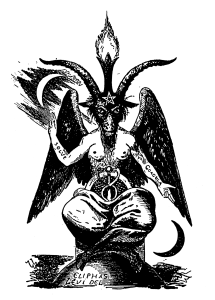 Another article in the pipe is a research piece on real world magic and its history, including its secular and religious branches. I honestly cannot guess how large this piece may grow and it may be delayed all the way until March of next year, as I’ve been trying to do reading outside of Wikipedia to prepare.
Another article in the pipe is a research piece on real world magic and its history, including its secular and religious branches. I honestly cannot guess how large this piece may grow and it may be delayed all the way until March of next year, as I’ve been trying to do reading outside of Wikipedia to prepare.
Magic can quickly become a fringe subject because certain topics aren’t really magic per say, or even necessarily religious. After reading Robert Lake-Thom’s Spirits of the Earth: A Guide to Native American Nature Symbols, Stories and Ceremonies, valid questions can be raised as to whether certain views are more philosophical over theological– if not even protoscientific, as he encouraged observation of nature for clues, hints and warnings.
On the fictional writing front, the second novella for Outliers has been dusted off and is back on track at more than 50% complete. And new, original novel is in the planning stages and will be shopped around to literary agents. The words won’t hit the paper until later next year as I’d rather front-load my research to prevent extensive refactoring against later facts. Magic being one needed subject, as well as the histories of certain European countries.
With regard to input, I’ve finished watching the aforementioned Jessica Jones as well as the latest season of The Leftovers. I won’t be doing a review of the latter, but I will say that I sincerely hope HBO agrees to produce more to enjoy the third and final season that was just (and I mean just) announced. I’ve heard the number of viewers is down, but those who do watch have become cultists for the show and the critics who are applauding this season.

On the reading front, I took a break from my non-fiction to totally absorb Robert Chambers’ The King in Yellow. Despite the power of the first four stories, the themes drifted away from their horror origins to become pure Parisian romance pieces. The cultural importance of the work cannot be denied; aside from the first season of True Detective, there are many other references to the city of Carcosa in The King in Yellow, such as in A Song of Ice and Fire and many, many other forms. It’s quite possible that reading the opening story, “The Repairer of Reputations” maybe some kind of unspoken litmus test for genre authors.
I’m honestly not sure why I decided to keep going after the fourth or fifth tale, but I felt it necessary to finish it just to ensure there wasn’t something I was missing. Other than Chambers’ love for all things French, it seems I did not. With this classic piece under my belt, I’ve decided to read Tony Hillerman’s Hunting Badger.
I may also take advantage of the holiday season to go ahead and wrap up several Oscar winning movies from years back. Recently I sat down to watch the rather long Once Upon a Time in the West and still need to sit down and watch 2001: A Space Odysseus. Older movies can be a little tiring because of Hollywood’s tendency to remake them. Thus the ideas are often already familiar and, sometimes, are even better than the original such as 

December 1, 2015
Character Design Writing Advice
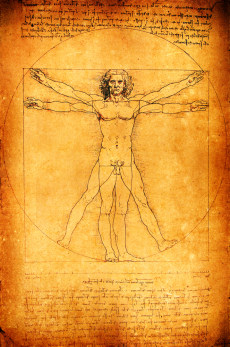 At almost any given time, a writer can find submission windows for “character driven” works of fiction. And even stories that are plot-driven are almost infinitely better with a good dose of personal development. For some writers, character development is very instinctive. Those folks may get some ideas from this post. However, this advice maybe invaluable to the other variety, who concoct great plots but have trouble creating characters who “stick” with their readers and fail to deliver the emotional power of personal growth and maturity.
At almost any given time, a writer can find submission windows for “character driven” works of fiction. And even stories that are plot-driven are almost infinitely better with a good dose of personal development. For some writers, character development is very instinctive. Those folks may get some ideas from this post. However, this advice maybe invaluable to the other variety, who concoct great plots but have trouble creating characters who “stick” with their readers and fail to deliver the emotional power of personal growth and maturity.
Before I begin the blog post, I would preface that this is simply an approach to development. There is no “one size fits all” methodology for design and authors should always be encouraged to try new techniques to prevent stagnation. Think of the advice in this post as a tool, to be used when and where your instincts say it is appropriate.
Pragmatism isn’t without virtue. Use what’s useful, ignore what isn’t, and always strive to do more.
Is a Character’s Personal History Necessary?
One of the most important questions an author should ask themselves when creating a tale is whether or not a character necessarily needs a background, at least at first.
From a franchise focus, character biographies are incredibly valuable. They offer depth and intrigue and can be a source of great stories in and of themselves thanks to something called the Zeigarnik Effect. They also help keep your characters more consistent, which is a must for longer, on-going arcs. Some story-featured video games even go so far as to have backstories constitute large portions (sometimes half) their material, such as Mass Effect 2 and Shadowrun Hong Kong.
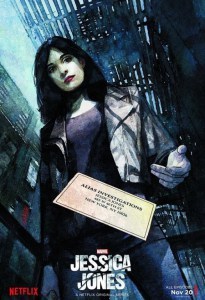 Backstories can intrigue readers but they often need to feel compelled to curiosity. Why does Professor Snape have it in for Harry Potter? What happened between Cobb and Mal in Inception that kept him from being able to go home to America? And the recent Jessica Jones on Netflix is an excellent example of why it can pay to hide a superhero’s background for a while, as opposed to revealing the origin story immediately.
Backstories can intrigue readers but they often need to feel compelled to curiosity. Why does Professor Snape have it in for Harry Potter? What happened between Cobb and Mal in Inception that kept him from being able to go home to America? And the recent Jessica Jones on Netflix is an excellent example of why it can pay to hide a superhero’s background for a while, as opposed to revealing the origin story immediately.
But if the goal is to write a short story around a totally fresh character, it may actually pay not to flesh out the personal history yet, or at least avoid exploring it in the current yarn. If a stranger tries to give us his/her life’s story at a bar, we’re usually not interested. But if we get to know them for a while, we might be inclined to ask how they became so funny or morose. Where they got that scar or what made them arrive in this town or city.
Likewise, it’s incredibly easy for a character’s history to devour more than its fair share from the precious word count. Tack on a greater plot arc and/or world building elements and it could easily become impossible to tell the story in fewer than 8,000 words.
Finally, it’s possible that the character in question could just stand on his/her own. Sometimes the audience can like a character for no other reason than the fact that they keep their issues to themselves and never become a distraction. Or maybe they have a great personality, or rather are a force of nature in someway. The latter might be called an “Unapologetic Hero.”
A character’s past is, more often than not, worth developing and discussing. But if you’re struggling to fit a 12,000 word tale into two-thirds that size, consider if the person’s history can be saved for exploration later. Or is needed at all– sometimes the mystery is better than the truth!
Homework Assignment: Think back on all the books, movies, games and television you’ve enjoyed. Pick out three to five characters you liked whose backgrounds are never explored. Try to discern why you were so impressed with them.
Put Philosophy & History Atop the Design Hierarchy
Philosophy, noun
the rational investigation of the truths and principles of being, knowledge, or conduct.
any of the three branches, namely natural philosophy, moral philosophy, and metaphysical philosophy, that are accepted as composing this study.
a particular system of thought based on such study or investigation
the critical study of the basic principles and concepts of a particular branch of knowledge, especially with a view to improving or reconstituting them
Admittedly, philosophy is a very large field of study to explain, especially for a blog post. Yet on the flip side, the subject is the source of many plot-driving elements. Politics, morality, personal discovery, ethics and growth, all are subsets of philosophy. When one sees political pundits arguing, they’re usually debating with thought-branches derived from fascinating roots of justification and rationale. Whether or not they express that critical thinking well is another matter…
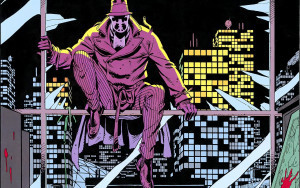 Developing a philosophy for a character is nothing less than 50% of that person. By creating guiding principles for characters, authors may find that their casts’ actions and reactions are a foregone conclusion. For example, Alan Moore realized the fate of Rorschach many, many issues before the conclusion of Watchmen, but not when first beginning to write the series.
Developing a philosophy for a character is nothing less than 50% of that person. By creating guiding principles for characters, authors may find that their casts’ actions and reactions are a foregone conclusion. For example, Alan Moore realized the fate of Rorschach many, many issues before the conclusion of Watchmen, but not when first beginning to write the series.
That is not to say that philosophy is the beginning and end of character design however. Much like the debate as to the origin of fear, philosophy can be constructed from experience, but may also overcome and learn from the past as well. History is very often the other half of a character. Nor is a person’s philosophy necessarily defined from the beginning, rather they may discover things about themselves when confronted with unforeseen situations. Marvel’s Daredevil addressed this very well. Try developing a character both ways; writing the philosophy first and then the history, and then vice versa. Then try it piece by piece.
Studying philosophy is best performed by forcing one to try and discover the rational arguments that maybe counter to one’s personal beliefs. If one is conservative, read more liberal news sources. If one is progressive, seek out counter viewpoints from the opposition’s own outlets. No matter how annoying or disgusting they may initially be, try not to block or mute friends and family whose political views mortify you. Try to learn the basis of their thinking and if nothing else, take a sharp look at history (personal or political) for the answer.
An estimate is better than a complete guess, and both are better than flat, uninspired stereotypes.
Homework Assignment: For fellow writers, take your character(s) and have them undergo a few basic ethics litmus tests, such as whether or not a person deserves less (or any) jail time for stealing a loaf of bread to feed their family. Try to find points of difference between your own views, to gauge whether or not you potentially have a Mary Sue.
Don’t Fear Hypocrites But Call Them Out
“A man always has two reasons for doing anything: a good reason and the real reason.”
–J.P.Morgan
If there was one consistent, perfect philosophy, would it wipe all others out like the correct answer to a math problem? Something proven true beyond the shadow of doubt, an approach to law and morality that everyone instinctively deems fair and reasonable? An approach to thinking that is always unlocking new knowledge and wisdom? A manner of reasoning that is so often “correct” that the philosophy itself is all but factually true?
Obviously, that has never happened. Well, maybe in the fairly utopian Federation of Star Trek, and that worked because the show’s conflict usually revolved around cultural friction between alien relations and galactic emergencies.
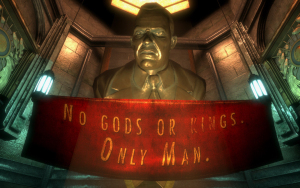 For the rest of us though, conflicts and hypocrisy abound in both real life and fiction. Hypocrisy, as a thematic element in storytelling, is an awesome source of intrigue. Many readers are strangely sympathetic to characters who do rotten, even heinous acts, provided either they know it’s wrong or figure some justification that leads to understanding of their decision. But it’s also something they cannot stand if improperly executed.
For the rest of us though, conflicts and hypocrisy abound in both real life and fiction. Hypocrisy, as a thematic element in storytelling, is an awesome source of intrigue. Many readers are strangely sympathetic to characters who do rotten, even heinous acts, provided either they know it’s wrong or figure some justification that leads to understanding of their decision. But it’s also something they cannot stand if improperly executed.
Dexter is a possible example of this very thing, while more critically acclaimed works include The Scarlet Letter, Andrew Ryan from Bioshock and the self-delusions of the lead characters of AMC’s Breaking Bad.
Strangely enough, even children shows can have surprisingly well performed moral-turns. In the episode “The Ultimate Doom” from the first television series of Transformers, paragon of justice Optimus Prime is convinced by the villainous Megatron to effectively betray the Earth. With their home planet suffering from an energy-famine, Prime feels forced to activate a device that summons Cybertron into our planet’s orbit. The gravity shift causes myriad environmental disasters. (If this plot sounds familiar, it’s because it was reused in the movie Transformers: Dark of the Moon.) For the previous episodes, it was easy to put a fellow like Optimus Prime on a pedestal for his benevolent behavior. But this particular episode was a shocking twist that made complete sense.
If poorly written however, it can be seen as a kind of violation of the writer’s contract with the reader at best, and a plot hole at worst. No one enjoys betrayal without explanation or at least some justification. Likewise, because hypocrisy can easily be intertwined with a person’s history, dealing with a moral twist effectively can greatly ramp up the needed word count to finish a story, so authors should be advised to factor the added pages when devising a manuscript.
Homework Assignment: What’s the fine line between hypocrisy and a change of opinion or growth? Do your characters answer that question the same way?
For Villains, Are They Unapologetic or Justified?
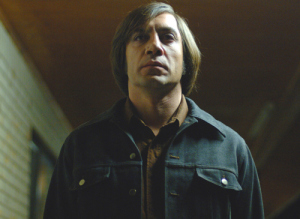 Villains. Gods, we love our villains.
Villains. Gods, we love our villains.
There’s a psychological trick at play when it comes to understanding why audiences love a strong villain, possibly because the role itself makes almost anything permissible. We can admire and respect them with sympathy, or we can despise and hate them with the most intense loathing and rancor… and neither is wrong.
Villains can be anything except boring.
As characters, the bad guys are primarily divided into two general categories. The justified types are often heroes of the other side, where the actual role and title of “villain” is debatable. Sometimes, authors deliberately cloud the definitions to let the readers define the heroes from the villains. Heroes on the wrong side of the story if you will. Justified villains may include…
Roy Batty, from Blade Runner , who attempted to extend the lifespan for both he and his colleagues, who were effectively genetically engineered slaves who live a mere four years.
The Operative, played by , in Serenity . Admittedly, the incident that the Operative was trying to cover up was terrible. However, it’s worth pointing out that keeping a lid on it also prevents others from using the same technology for horrific ends.
Doctor Octopus of Spider-Man 2 . The accident that pushed him over the edge was really just that, an accident. Meanwhile, the work he was doing could have greatly revolutionized energy production.
Julie Marsden of Jezebel , whose vanity costs her engagement to Preston Dillard. Her antics were a threat to her former fiance’s marriage and later his life. She does however, somewhat prove her genuine love for him by offering to treat his yellow fever in place of his wife.
A few of the major characters of Watchmen , who will not be mentioned as to protect the reader from spoilers.
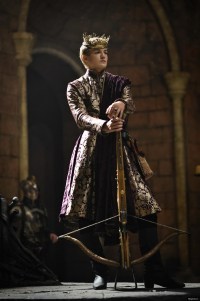 But there are also the unapologetic types. True forces of nature, these types are motivated either by forces we may not (and perhaps never will) comprehend, or by understandable but primal forces or desires.
But there are also the unapologetic types. True forces of nature, these types are motivated either by forces we may not (and perhaps never will) comprehend, or by understandable but primal forces or desires.
The Joker, both in The Dark Knight and Alan Moore’s The Killing Joke, who was effectively raw chaos and randomness.
Anton Chigurh from No Country For Old Men , both the book and movie. It can be said that Chigurh is little more than an avatar of death itself.
The shark from Jaws , as it was an animal acting entirely on instincts.
Likewise, the xenomorphs from the Aliens franchise, as their predatory instincts were a key factor to their reproduction.
Cthulu from the mythos of H.P. Lovecraft.
George RR Martin uses both varieties in A Song of Ice and Fire. For the justified, he divides his readers, causing them to cheer for various contenders for the throne, yet making the choices gray and not without cost, such as Stannis Baratheon or Daenerys Targaryen. Likewise, he uses a slew of entirely despicable types who provide no excuse for their antics, such as Joffrey Baratheon and Ramsay Snow.
Homework Assignment: Here’s a real tough one. Was John Doe, the villain of Se7en, a justified villain or an unapologetic one? Or was he both?


November 23, 2015
Penny Dreadful Season 2 Recap & Review
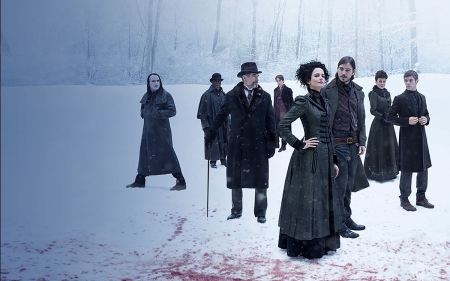
This review contains spoilers.
Whatever weaknesses the first season of Penny Dreadful suffered from, the second has completely overcome them like a vampire who has discovered how to exist in daylight. The character development paces better and covers the whole cast, while the story expands and the plot thickens in all the right ways. Penny Dreadful season two is superior in every way.
Once again the intrigue revolves around Vanessa Ives (), sought by the Devil for her incredible abilities as a spiritual medium and, as we discover, witchcraft. However her friends and protectors within the home of Malcolm Murray () are distracted by powerful dilemmas and charmed by new, terrible foes; a coven of witches known as the Nightcomers. Servants of the Devil who are capable of acting in both and day and night and in public or shadows, they’ll stop at nothing to have Ives as the bride of Lucifer.
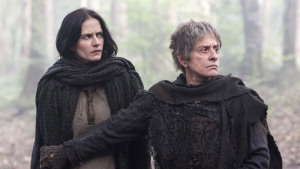 In the flashback episode “The Nightcomers” we learn of Joan Clayton (), the Cut-Wife, who reluctantly comes to protect and mentor Vanessa in both sides of the magical arts. Although only present for a single episode, LuPone’s performance beautifully portrayed her character as she balanced the line between her pragmatism and loneliness, a woman with a rough exterior that belies her genuine good heart.
In the flashback episode “The Nightcomers” we learn of Joan Clayton (), the Cut-Wife, who reluctantly comes to protect and mentor Vanessa in both sides of the magical arts. Although only present for a single episode, LuPone’s performance beautifully portrayed her character as she balanced the line between her pragmatism and loneliness, a woman with a rough exterior that belies her genuine good heart.
By transferring the focus from Vanessa to Joan, showrunner John Logan wisely prevents audience-fatigue with Ms Ives while still strengthening her background. Furthermore, the connection between the two women improves our understanding of Vanessa’s knowledge and sets the stage for a test against her soul. Joan is connected to the aforementioned coven of witches, as her sister is none over than head-witch Madame Kali, who has long coveted Vanessa. returns as said villain, revealing herself as the true foe after a brief guest star role during the first season. Her coven’s unusual methods of subversion result in Clayton’s tragic immolation by a mob, and set the stage for Vanessa to seek vengeance. More on Kali in a moment.
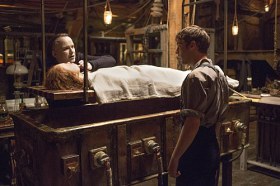
Meanwhile Victor Frankenstein () struggles to keep a cap over the events of the first season, which are unraveling in ways brilliant and unexpected. The fury of the Creature () has been temporarily assuaged with the death and revival of the “Bride of Frankenstein” Lily (), whom veterans of the earlier season will recognize as Brona, Ethan Chandler’s former lover, and the prostitute once in service to Dorian Gray.
Victor persuades the Creature to grant the young doctor time to teach Lily, as to prevent the confusion and horrors that befell his first creation. The situation sets up an inevitable conflict between Dr. Frankenstein and his friend Ethan () who believes Brona dead and gone, but this has yet to pass. Worse yet, Lily’s innocence and interest in the world lead Victor to fall for his third creation, blinding him to the fact she has recollected her memories.
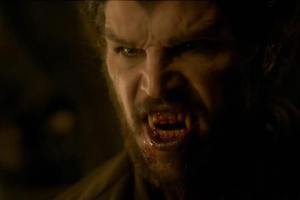 Meanwhile, Ethan Chandler has his own problems. The law has not forgotten the hotel massacre committed by Ethan’s werewolf persona. Nor has the lone surviving bounty hunter, who attempted to capture Ethan for delivery back to his as-of-yet unrevealed father.
Meanwhile, Ethan Chandler has his own problems. The law has not forgotten the hotel massacre committed by Ethan’s werewolf persona. Nor has the lone surviving bounty hunter, who attempted to capture Ethan for delivery back to his as-of-yet unrevealed father.
The legal pressure on Ethan grows thanks to macabre Inspector Bartholomew Rusk () who reveals Ethan’s real surname as Talbot, hinting at the identity of his father. The increased police presence is felt by the residents of Sir Murray’s Manor, and Ethan turns to Murray’s Senegalese servant Sembene, played by , to help manage his lunar proclivities. These revelations further build their friendship.
Finally, Sir Malcolm Murray himself grapples with the demons of his past. The death of his vampire daughter Mina has destroyed what little remained of his marriage to Gladys () and has left him persona non-grata in his wife’s presence. Yet honor prevents an official divorce. This unfortunate situation is “resolved” by an affair he has with Madame Kali, unaware of her motivations. The curses spun by her coven soon leave Gladys buried alongside both her dead children… a death seemingly by her own hand.
On the other side of the fence, Dorian Gray (Reeve Carney) has slowly emerged as a villain in his own right. Starting a relationship with transgender prostitute Angelique (), the show reminded us of the times and how their relationship would be generally frowned upon. Dorian himself seems admirable, a true gentleman despite the struggles Angelique has with her identity.
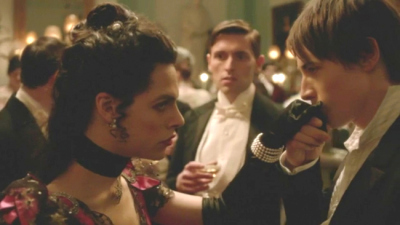
Unfortunately for Angelique, she stumbles upon Gray’s secret and we learn that even her acceptance of it isn’t enough to keep him from insuring her silence. Angelique’s murder feels complicated by myriad reasons. Keeping her from talking is but one, rather Dorian may have found some thrill in betraying and killing someone he loved. It could also have been because Dorian needed to clear the way for his new relationship with Brona, who seems intent on taking revenge upon the world itself for her previous, abused life.
The ending is powerful, shattering the group’s cohesion entirely. Victory was very costly, as the psychic assault the coven leveled against Sir Murray and Dr. Frankenstein drove them to the brink, while Ethan was tricked into committing a terrible act against his friend. Vanessa Ives emerged from her struggle the least damaged and even stronger for it, but seems the only one to do so. And although Madame Kali was defeated and slain (though death is questionable when the devil is involved), her treacherous daughter Hecate Poole () escaped to cause havoc another day.
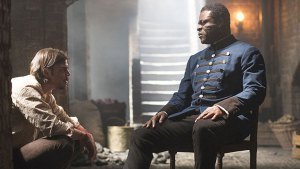 The hardest hitting moment of the season was undoubtedly Sembene’s death, at the hands of a transformed Ethan. The Senegal hunter had become an intriguing and likable character despite his aura of mystery, and watching his friendship with Ethan grow was remarkably enjoyable. It seemed likely that Danny Sapali was let go from the show for good, as he joined the cast of The Bastard Executioner. However, with that show’s cancellation, and how often Penny Dreadful reverses death, a window is open for Sapali’s return.
The hardest hitting moment of the season was undoubtedly Sembene’s death, at the hands of a transformed Ethan. The Senegal hunter had become an intriguing and likable character despite his aura of mystery, and watching his friendship with Ethan grow was remarkably enjoyable. It seemed likely that Danny Sapali was let go from the show for good, as he joined the cast of The Bastard Executioner. However, with that show’s cancellation, and how often Penny Dreadful reverses death, a window is open for Sapali’s return.
For the rest of the cast, they become divided and ultimately alone. Victor Frankenstein, upon discovery of Brona’s rage, takes to the needle. Likewise the heartbroken Creature joins an expedition going north, after Brona rejects him and the family for whom he worked attempted to turn him into a freakshow attraction at a wax museum. A regretful Ethan Chandler turns himself in, only to discover that Rusk has orders to send him back to America. Murray returns to Africa with Sembene’s body. Only Vanessa stays put, alone in the manor.
As it stands, the third season is setting itself up for the difficult task of covering multiple plot lines. With the crew so scattered, the expansion of the story will be quite demanding. Season three is set to premiere in Q2, 2016.


November 12, 2015
The Gift of Hadrborg
Today marks the launch of the Banner Saga: Warbands Kickstarter! Based on the hit game created by Stoic Studio, the board game continues combining tactical skirmishes with long term resource management to survive. And the even more incredible news is that, within about 30 minutes, the KickStarter has already been entirely funded.
Of interest to readers out there is that my first novel, The Gift of Hadrborg, is an add-on available to anyone who joins the funding. Inspired by The Banner Saga: Factions, the story takes place before the events of the first game and tells the tale of Eirik and the woes of a city suffering from crime and strife.
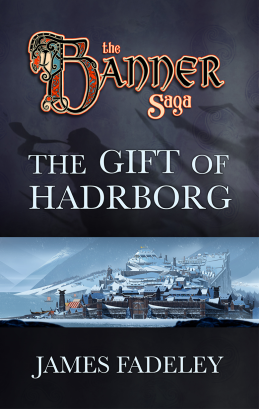
In the troubled city of Strand, the City Watch and Governor’s Guard struggle to fend off the criminal empires who rule their streets. Between the corruption, smuggling, underground slaving, mass larceny and a rebellious group attempting to usurp the throne, Guardsman Eirik’s life shows no signs of getting any easier.
Yet the arrival of group seeking a stolen artifact heralds a coming disaster for the already rotten city. Uncertain if he can trust his own people, Eirik has little choice but to throw in his lot with two enigmatic varl and a country boy. Toss in a conman seeking vengeance and a slave-turned-bodyguard with an elusive agenda, and Eirik has his work cut out for him.
But even if his questionable allies and the hordes of eager thugs don’t kill him, the plot they discover threatens to rip Strand apart. And may destroy the fragile varl-human alliance that maintains the peace with their giant neighbors in the north…
The Gift of Hadrborg is an action-packed prequel novel to Stoic Studio’s critically acclaimed The Banner Saga Part 1, which was funded through Kickstarter to wild success.
A viking-fantasy meets crime thriller, The Gift of Hadrborg will help satiate story-lovers whether or not they’re salivating for the next installment of The Banner Saga series! But no matter what, check out the KickStarter. Whether you love great games or stories (or both), Stoic Studio, VS Evil and Megacon Games have got you covered!


October 27, 2015
The Story’s The Thing!
That is the ailment of the month. A document keeps expanding whenever innovation strikes, as elements of a new novel are jotted down. It’s a yarn built upon twin short stories, both pitched to various publishers but rejected with encouraging remarks. A lack of depth is the usual problem, and that is the much sought solution.
The background for SFF novels often times becomes a double-trap for young authors. Fledgling word-smiths frequently fly by the seat of their pants, relying on strictly their imagination to fill in the blanks. At worst, the results are derivative of that writer’s most recent literary conquest. At best, their concoction is remarkably original but devoid of particulars and technicalities which audiences crave– with proper delivery.
Likewise, the note-taking developer types with their pseudo God-complexes can become so involved with research into each organization, country and character that production slows to a crawl. However should the effort avoid the pitfall of becoming a textbook of fiction, the outcome is often an achievement.
Such truths could sour hopes for the junior scribe. Yet the most memorable books often borrow strongest from true life. Robert E. Howard is said to have once stated, “There is no literary work, to me, half as zestful as rewriting history in the guise of fiction.” J.R.R. Tolkien drew heavy inspiration from Norse mythology including Elves, Dwarves and Der Ring des Nibelungen. And George R.R. Martin’s A Song of Ice and Fire draws inspiration from the War of Roses and, some believe, a few other sources.
Admittedly these facts are a deterrent. There is little pleasure to be derived from the crestfallen countenances of dreamers-turned-skjalds for whom this is the lesson du jour. The fusion of economics, history, politics, culture, religion, psychology and science and/or the occult into a tale is no trick. Such intellectual pack-rats authors can become, for no esoteric knowledge is worthless.
The cynicism is due to timing. National Novel Writing Month has nearly arrived. An event that floods publishers and book delivery platforms with thousands of manuscripts. An event sponsored and encouraged by various groups who financially benefit from the stoked competition that spawns the deluge. An event that sparks the yin and yang of ambivalent emotions; a desire to be encouraged and see folks succeed, yet fearing the earnest zeal of effort that shall be futilely deflected against an uncaring public.
There is the rest of the year to be a scrivener who needs no crutch. For now, the innovations shall brew and storm, a time of rest from the inferno that serves others and not the creator. And December shall be the month when the ink touches the page.


October 23, 2015
Battletech Memories and Favorites
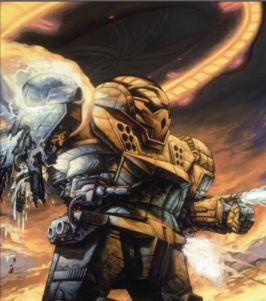 The Battletech Kickstarter is doing very well, so it seems a good time to discuss the nostalgia consuming my psyche. I admire how Harebrained Schemes has been stirring fan conversations, either to gather metrics for game design (preferred mechs, ideas for mission designs) or just to generate PR buzz or maybe just for fun. But it’s effective and has gotten fans stoked.
The Battletech Kickstarter is doing very well, so it seems a good time to discuss the nostalgia consuming my psyche. I admire how Harebrained Schemes has been stirring fan conversations, either to gather metrics for game design (preferred mechs, ideas for mission designs) or just to generate PR buzz or maybe just for fun. But it’s effective and has gotten fans stoked.
I guess the best way to kick off is by telling a secret. Battletech played a major role in inspiring me to become a writer.
I’m serious. My first introduction to the Battletech Universe was through Mechwarrior 2. I procured the game on a whim, after having scored a fine report card and earning a reward from my parents.
While browsing PC games, a tough decision was laid before me. I very nearly took home a copy of Crusader: No Remorse. In the end, the classic mech sim won out. That very night I installed and played through a training mission. At first, I couldn’t figure out how to walk. However, I discovered that by shifting left and right, I inched forward just a little bit.
You read that correctly. I penguin walked my mech to my very first objective.
Two minutes of studying the instruction manual later I discovered this nifty thing called “throttle.” Before I knew it, my Firemoth was rushing from Alpha to Bravo, actually completing the laundry list of goals to accomplish. Everything after that was smooth sailing.
Until I accidentally fired a potshot at my training commander.
One violent death later and I was hooked. The game had no play timer that I knew about, but hundreds of hours of my childhood were invested playing and replaying trial missions and beating both campaigns inside and out.
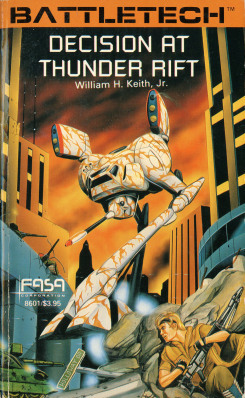 As I progressed, I spent some time trying to understand the greater conflict between Clans Wolf and Jade Falcon and the universe as a whole. Later, while at the local bookstore, I noticed a connection between Mechwarrior and Battletech. That’s when I received my first Battletech novel, Decision at Thunder Rift.
As I progressed, I spent some time trying to understand the greater conflict between Clans Wolf and Jade Falcon and the universe as a whole. Later, while at the local bookstore, I noticed a connection between Mechwarrior and Battletech. That’s when I received my first Battletech novel, Decision at Thunder Rift.
For the audience members who haven’t read it, the book revolves around young Grayson Death Carlyle, son of the leader of Carlyle’s Commandos. While stationed on the desert planet of Trellwan, a bandit ambush cost Grayson his father, his unit and his inheritance.
Grayson survives, but is left stranded on a planet that has become hostile. However, after jumping into a battle between the bandits and the local militia, Grayson manages to turn his luck around and convince Trellwan’s government to set up their own Battlemech lance. Yet before he can finish off the bandits, Grayson is plunged into a greater political plot that threatens his home nation.
As a thirteen year old kid, this novel blew my mind. William H. Keith Jr did an amazing job of grabbing the reader’s attention regardless of their age and throwing them into the adventures, political intrigue and battles of the 31st century.
And as if it wasn’t awesome enough, the sequel Mercenary’s Star was even better. The kind of perfect guerrilla war story that was rife with conflict, challenges and betrayals. These tales helped set me down the path of trying to polish my writing craft on online message boards. Sometimes I produced fan fiction, and sometimes it was original pieces. Mechwarrior was a ton of fun, but it was Keith’s awesome novels that made me want to become a scribe in my own right.
Back to the games themselves. Not long after Mechwarrior 2 came the Ghost Bear’s Legacy expansion, followed by my absolute favorite entry of the entire franchise, Mechwarrior Mercenaries. It was in this title that I developed a preference for medium battlemechs. They possess very good speed, can absorb some punishment and usually provide just enough firepower to legitimately threaten far-end heavies and assault mechs.
And as Mercenaries taught me, they’re a good price. Everything I thought I learned about being a Mechwarrior was turned upon its head once I learned to manage the flow of C-Bills. Before, the only punishment for using missiles and ballistic weapons was simply a little less ammunition with which to complete that mission. But the addition of financial considerations make me consider the price of every shot and every expenditure. And rewarded me with savings for preferring energy weapons.
For that reason, I have to give two mechs which I consider my favorites.
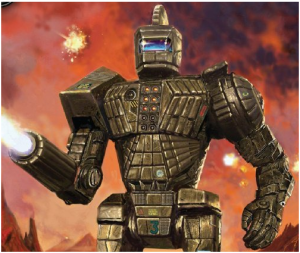 The first is the Crab. I first piloted this mech during a campaign between rebel forces and House Kurita during Mechwarrior Mercenaries. The Crab’s exclusive focus on energy weapons, including two useful large lasers, helped me to outlast the competition and saved money in the long run. For the attrition-minded, you just can’t beat the value of a Crab piloted by a skilled mechwarrior.
The first is the Crab. I first piloted this mech during a campaign between rebel forces and House Kurita during Mechwarrior Mercenaries. The Crab’s exclusive focus on energy weapons, including two useful large lasers, helped me to outlast the competition and saved money in the long run. For the attrition-minded, you just can’t beat the value of a Crab piloted by a skilled mechwarrior.
The second must be the classic Centurion. Sure, I could easily list the Shadow Hawk, Wolverine or Griffin, all respected for their well-rounded designs. But while the trio were jack-of-all-trade types, the Centurion knew its role; peppering foes from afar and preferring to outgun over outrun the competition. When paired with other mechs, it did a great job at fire support. On its own, a strong raider.
The further along the Kickstarter gets, the more convinced I am that it’s the game I didn’t even know I wanted until now. All the elements of Mechwarrior Mercenaries with the tactical considerations of Mech Commander. A persistent lance, missions throughout the entire Inner Sphere and hopefully multiplayer arena battles, all set in the era of classic Battletech. 2017 never seemed so far away.







